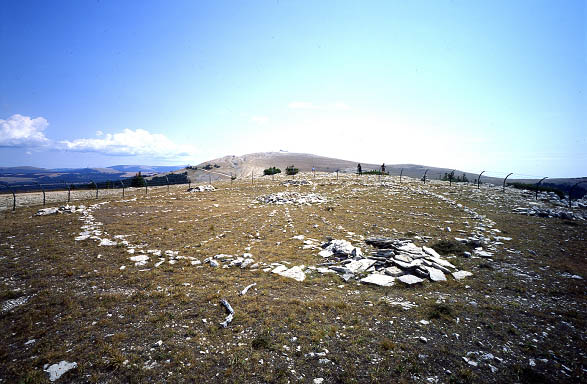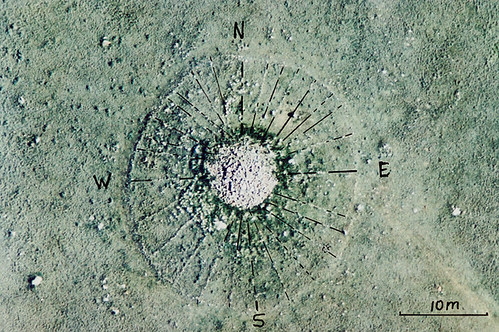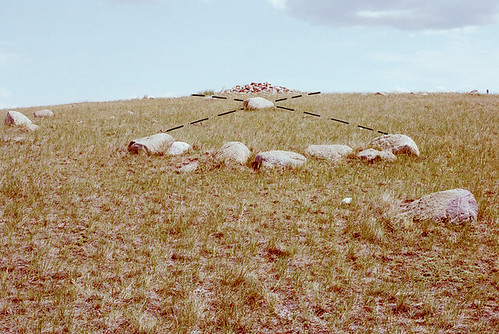The Medicine Wheels of North America
Nearly every ancient civilization has studied the night sky, whether it was for navigation, measuring time, or spiritual purposes. The Plains Indians of North America were no exception. Dotting the high hills of the northern plains are hundreds of Native American stone constructions, called medicine wheels, that some scientists and historians believe to be aligned with the stars. In the past few decades, the field of archaeoastronomy, which aims to uncover how past civilizations understood celestial phenomena, has turned to medicine wheels to demonstrate the Native Americans’ grasp of the heavens.
The archaeologist John Brumley has developed an official definition for the medicine wheel. According to Brumley, a medicine wheel contains at least two of the following three criteria:
1)a central stone cairn
2)one or more concentric stone circles, and/or
3)two or more stone lines radiating outward from a central point.
Using this definition, the number of remaining medicine wheels is estimated to be between 100 and 200, each of which has a completely unique form. A vast majority of these wheels are found in Alberta and Saskatchewan, but some are located in North Dakota, Wyoming, Montana, and Colorado.Some even consider the wheels endangered because like tipi rings, the stone structures are threatened by theft, vandalism, and agriculture.
Even with a clear-cut definition such as Brumley’s, medicine wheels, or “sacred hoops” as some prefer, are curious constructions. They have been used by generations of Native Americans, but there is no clear consensus of their origin or purpose. Rather, the wheels serve a multitude of uses to various different tribes. Even within a certain group, the specific rituals and ceremonies performed at the sacred wheels have been known to change over time. To add to the confusion, medicine wheels have been appropriated by New Age spiritualists, Wiccans, and Pagans. Gradually, these spiritual groups have attached their own syncretic meanings to the ancient constructions.
One far out explanation offered by the Swiss author Erich von Däniken suggests that medicine wheels represent a link between the Native Americans and pre-historic alien astronauts. Most scientists, however, tend to favor a more earthly interpretation. One popular, but controversial, theory is that medicine wheels are ancient observatories of sorts. This explanation, put forth by the astronomer John “Jack” Eddy in the 1970s, rests upon the fact that medicine wheel geometries can often reflect various celestial alignments. Three medicine wheels in particular have been important in advancement of this theory: Bighorn Medicine Wheel in Wyoming, Majorville Medicine Wheel in Alberta, and Moose Mountain Medicine Wheel in Saskatchewan.
Bighorn Medicine Wheel, Medicine Mountain, Wyoming, USA
The Bighorn Medicine Wheel is perhaps the most famous of all medicine wheels. At an altitude of nearly 10,000 feet, the wheel at Bighorn is only accessible during the summer months. For the rest of the year, the stones are covered by heavy snows.The geometry of the structure is described by a central cairn, large enough to contain a sitting person, surrounded by 28 spokes emanating outward and six other cairns placed along the outer circumference of the wheel.
Sitting in one cairn and looking towards another determines a line-of-sight that terminates in a specific point on the distant horizon. In the 1970s, Dr. Eddy showed that two of these sightlines corresponded to fixed points on the sky where the sun would rise and set on the summer solstice, the longest day of the year. Furthermore, Eddy found that other cairn alignments pointed to spots where the heliacal risings of several bright stars could be observed. Heliacal risings occur when a star reappears at dawn after being washed out by the sun’s light for an entire season. These events are special in that they mark a specific day on the calendar. In the case of Bighorn, it is thought that the heliacal risings would have helped signal the onset of the snow season, thereby allowing the Native Americans sufficient time to safely journey down the mountain.
Aerial photo and diagram showing the astronomical alignments of Bighorn Medicine Wheel.
Majorville Medicine Wheel, Majorville, Alberta, Canada
The largest extant medicine wheel is located near Majorville in southern Alberta. The Majorville Medicine Wheel consists of a central cairn, 9 meters across, with 28 spokes radiating outward to form an outer ring that is 27 meters in diameter. At around 5,000 years old, the medicine wheel at Majorville is also the oldest known. Dating of the wheel was first done by examining the style of spear points and arrowheads at the site. The stylistic changes of such objects over time is regular enough for this method to be considered a reliable dating technique. Nevertheless, the age of the wheel was later corroborated by precise radiocarbon dating of bone fragment found at the bottom of the cairn.
In his book,”Canada’s Stonehenge,” the scientist Gordon Freeman asserts that the Majorville stones are really the remains of an open-air sun temple that predates both Stonehenge in England and the Pyramids in Egypt. According to Freeman, the Plains Indians used the temple to observe sunrise on the winter and summer solstices.
Gordon Freeman observing at Majorville on the winter solstice.
Gordon Freeman’s aerial photo of the Majorville Medicine Wheel, with the 28 spokes highlighted in black.
View from the ground towards the central cairn at Majorville.
Moose Mountain Medicine Wheel, Moose Mountain, Saskatchewan
The medicine wheel at Moose Mountain has a different geometry than that of Majorville or Bighorn. A central cairn is surrounded by just five spokes, with an outer ring 30 feet in diameter. The spokes extend far beyond the outer ring, with the longest one measuring 123 feet and marking the summer solstice sunrise. Like Bighorn, other cairn alignments point to the heliacal risings of the bright stars Aldebaran, Fomalhaut, Rigel, and Sirius.
While the wheel itself has been carbon-dated to be around 2600 years old, it first appeared in the written record in 1895. Surveyors at that time noted the presence of a central cairn about 14 feet high. Today, that cairn stands only a foot and a half tall, perhaps as a result of theft and vandalism. Despite having many of the same alignments as Bighorn, Moose Mountain is used by the archaeologist Ian Brace to challenge the astronomical theory. According to Brace, the work of carrying out alignments over the 17-foot crest that separates one end of the Moose Mountain wheel from the other would be far too difficult. However, John Eddy calculated the probability of a chance alignment to be less than 1 in 4,000.
The Moose Mountain Medicine Wheel, seen circa 1910.
Photo Courtesy the Virtual Museum of Canada
http://www.royalalbertamuseum.ca/human/archaeo/faq/medwhls.htm
http://www.absoluteastronomy.com/topics/Medicine_wheel
http://www.virtualsk.com/current_issue/endangered_stones.html
http://library.thinkquest.org/C0118421/wheel2.html
http://www.crystalinks.com/medicinewheel.html
http://www.astronomy.pomona.edu/archeo/plains/plains.html
http://www.kstrom.net/isk/stars/starkno8.html#wheel










Follow us on Twitter to get the latest on the world's hidden wonders.
Like us on Facebook to get the latest on the world's hidden wonders.
Follow us on Twitter Like us on Facebook